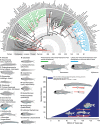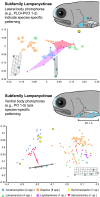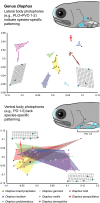Species-specific bioluminescence facilitates speciation in the deep sea
- PMID: 24771948
- PMCID: PMC3996283
- DOI: 10.1007/s00227-014-2406-x
Species-specific bioluminescence facilitates speciation in the deep sea
Abstract
The vast darkness of the deep sea is an environment with few obvious genetic isolating barriers, and little is known regarding the macroevolutionary processes that have shaped present-day biodiversity in this habitat. Bioluminescence, the production and emission of light from a living organism through a chemical reaction, is thought to occur in approximately 80 % of the eukaryotic life that inhabits the deep sea (water depth greater than 200 m). In this study, we show, for the first time, that deep-sea fishes that possess species-specific bioluminescent structures (e.g., lanternfishes, dragonfishes) are diversifying into new species at a more rapid rate than deep-sea fishes that utilize bioluminescence in ways that would not promote isolation of populations (e.g., camouflage, predation). This work adds to our understanding of how life thrives and evolution shaped present-day biodiversity in the deep sea, the largest and arguably least explored habitat on earth.
Figures




References
-
- Bolin RL. A review of the myctophid fishes of the Pacific coast of the United States and of Lower California. Stanf Ichthyol Bull. 1939;1:89–156.
-
- Bolin RL (1959) Iniomi. Myctophidae from the "Michael Sars" North Atlantic deep-sea expedition 1910. Rep Sci Res "Michael Sars" Deep-Sea Exped 4(7):1–45
LinkOut - more resources
Full Text Sources
Other Literature Sources
